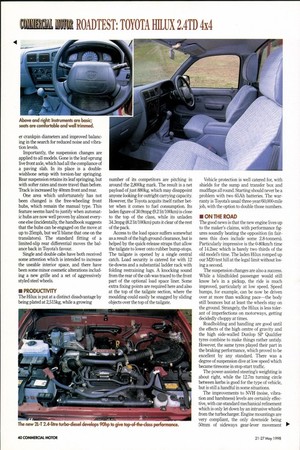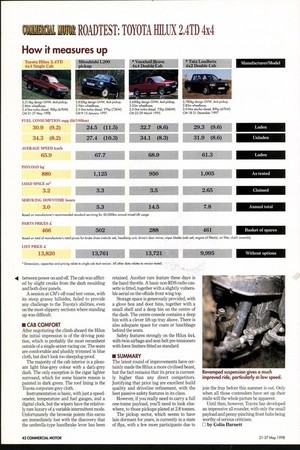-THE HILUX PICKS UP Until last autumn, Toyota's Hilux pickup
Page 39

Page 40

Page 42

If you've noticed an error in this article please click here to report it so we can fix it.
was singularly ill-placed to compete in the UK market-place. Its ridiculously hard suspension might have been suited to the dirt tracks of east Africa, but it struggled to cope with the cash-starved highway network of this country. Under the bonnet its power output left little in reserve for the unforeseen things of life, like loads and hills, particularly on the 4x4s. Now the good news: it's all changed...
Toyota has answered the criticisms of hard suspension and low power in the shape of the recently revamped Hilux pickup range. A reply was definitely needed if Toyota is to make an impression in a market sector in which the stakes have been raised considerably since the original Hilux was launched—and more new models are on the launch pad for this year.
• PRODUCT PROFILE The Hilux range now consists of three models: two or four-wheel-drive single-cab versions, and a double cab which is available only with four-wheel drive. The 4x2 model continues to 6 be powered by the 78hp (58kW) naturally aspirated diesel from the previous model; both 4x4s get the new turbo-diesel. 1 The new 4L-T engine is equipped with a 8 water-cooled turbocharger working with new torque-enhancing camshaft profiles. The E result is a conservative power increase to 90hp (67kW) produced 500rpm lower at 3,500rpm and, more importantly, a 40% torque boost to 226Nm (1671bft) at the same 2,200rpm. The crankshaft benefits from larg Price as tested £14,113 (ex-VAT), includes £13,820 for the basic vehicle; £293 for the loadspace liner. Engine: 2.4-litre, 90hp (67kW) turbo-diesel.
GVW: 2,515kg. Payload. 880kg. Fuel consumption (laden): 30.9mpg (9.21it/100km). er crankpin diameters and improved balancing in the search for reduced noise and vibration levels.
Importantly, the suspension changes are applied to all models. Gone is the leaf-sprung live front axle, which had all the compliance of a paving slab. In its place is a doublewishbone setup with torsion-bar springing. Rear suspension retains its leaf springing, but with softer rates and more travel than before. Track is increased by 40nun front and rear.
One area which unfortunately has not been changed is the free-wheeling front hubs, which remain the manual type. This feature seems hard to justify when automatic hubs are now well proven by almost everyone else (incidentally, the handbook suggests that the hubs can be engaged on the move at up to 25mph, but we'll blame that one on the translators). The standard fitting of a limited-slip rear differential moves the balance back in Toyota's favour.
Single and double cabs have both received some attention which is intended to increase the useable interior space, and there have been some minor cosmetic alterations including a new grille and a set of aggressively styled steel wheels.
• PRODUCTIVITY The Hilux is put at a distinct disadvantage by being plated at 2,515kg, while a growing number of its competitors are pitching in around the 2,800kg mark. The result is a net payload of just 880kg, which may disappoint anyone looking for outright carrying capacity. However, the Toyota acquits itself rather better when it comes to fuel consumption. Its laden figure of 30.9mpg (92 lit/100km) is close to the top of the class, while its unladen 34.3mpg (82 lit/100km) puts it clear of the rest of the pack.
Access to the load space suffers somewhat as a result of the high ground clearance, but is helped by the quick-release straps that allow the tailgate to lower onto rubber bump-stops. The tailgate is opened by a single central catch. Load security is catered for with 12 tie-downs and a substantial ladder rack with folding restraining lugs. A knocking sound from the rear of the cab was traced to the front part of the optional load space liner. Some extra fixing points are required here and also at the top of the tailgate section, where the moulding could easily be snagged by sliding objects over the top of the tailgate. Vehicle protection is well catered for, with shields for the sump and transfer box and mudflaps all round. Starting should never be a problem with two 65Ah batteries. The warranty is Toyota's usual three-year/60,000-mile job, with the option to double those numbers.
• ON THE ROAD The good news is that the new engine lives up to the maker's claims, with performance figures soundly beating the opposition (in fairness this does include some 2.8-tonners). Particularly impressive is the 0-80km/h time of 14.2sec which is barely two thirds of the old model's time. The laden Hilux romped up our M20 test hill at the legal limit without losing a second.
The suspension changes are also a success. While a blindfolded passenger would still know he's in a pickup, the ride is much improved, particularly at low speed. Speed humps, for example, can be now be driven over at more than walking pace—the body still bounces but at least the wheels stay on the ground. Strangely, the Hilux is less tolerant of imperfections on motorways, getting decidedly choppy at times.
Roadholding and handling are good until the effects of the high centre of gravity and the high side-walled Dunlop SP Qualifier tyres combine to make things rather untidy. However, the same tyres played their part in the braking performance, which proved to be excellent by any standard. There was a degree of suspension dive at low speed which became tiresome in stop-start traffic.
The power-assisted steering's weighting is about right, while the 12.7m turning circle between kerbs is good for the type of vehicle, but is still a handful in some situations.
The improvements to NVH (noise, vibration and harshness) levels are certainly effeetive, with car-standard mechanical refinement which is only let down by an intrusive whistle from the turbocharger. Engine mountings are very compliant, the only downside being 50mm of sideways gear-lever movement ■ between power on and off. The cab was afflicted by slight creaks from the dash moulding and both door panels.
A session at CM'S off-road test venue, with its steep grassy hillsides, failed to provide any challenge to the Toyota's abilities, even on the most slippery sections where standing up was difficult.
• CAB COMFORT After negotiating the climb aboard the Hilux the initial impression is of the driving position, which is probably the most recumbent outside of a single-seater racing car. The seats are comfortable and plushly trimmed in blue cloth, but don't look too sheepdog-proof.
The majority of the cab interior is a pleasant light blue-grey colour with a dark-grey dash. The only exception is the cigar lighter surround, which for some bizarre reason is painted in dark green. The roof lining is the Toyota corporate grey cloth.
Instrumentation is basic, with just a speedometer, temperature and fuel gauges, and a digital clock, but the wipers have the relatively rare luxury of a variable intermittent mode. Unfortunately the brownie points this earns are immediately lost with the discovery that the umbrella-type handbrake lever has been retained. Another-rare feature these days is the hand throttle. A basic non-RDS radio cassette is fitted, together with a slightly vulnerable aerial on the offside front wing top.
Storage space is generously provided, with a glove box and door bins, together with a small shelf and a deep bin on the centre of the dash. The centre console contains a deep bin with a clever lift-up tray above. There is also adequate space for coats or lunchbags behind the seats.
Safety features strongly on the Hilux 4x4, with twin airbags and seat-belt pre-tensioners with force limiters fitted as standard.
• SUMMARY The latest round of improvements have certainly made the Hilux a more civilised beast, but the fact remains that its price is currently higher than any direct competitors. Justifying that price tag are excellent build quality and driveline refinement, with the best passive safety features in its class.
However, if you really need to carry a full one-tonne payload, you'll need to look elsewhere, to those pickups plated at 2.8 tonnes.
The pickup sector, which seems to have lain dormant for years, is currently in a state of flux, with a few more participants due to join the fray before this summer is out. Only when all those contenders have set up their stalls will the whole picture be apparent.
Until then, however, Toyota has developed an impressive all-rounder, with only the small payload and penny-pinching front hubs being worthy of serious criticism.
II by Colin Barnett






















































































































